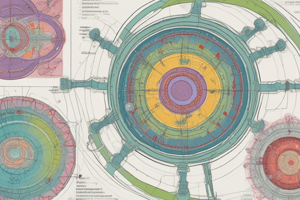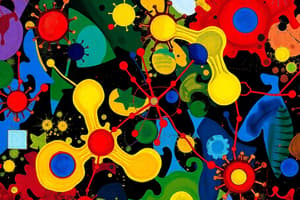Podcast
Questions and Answers
Cyclin E expression is promoted by the action of E2F.
Cyclin E expression is promoted by the action of E2F.
True (A)
P53 is primarily responsible for promoting the cell cycle progression.
P53 is primarily responsible for promoting the cell cycle progression.
False (B)
The G1/S checkpoint is regulated by the activity of cyclin-CDK complexes.
The G1/S checkpoint is regulated by the activity of cyclin-CDK complexes.
True (A)
ATM/ATR are kinases that are activated in response to DNA damage.
ATM/ATR are kinases that are activated in response to DNA damage.
The anaphase-promoting complex (APC) inhibits degradation of mitotic cyclins to ensure proper chromosome segregation.
The anaphase-promoting complex (APC) inhibits degradation of mitotic cyclins to ensure proper chromosome segregation.
Proto-oncogenes can become oncogenes through mutations that increase protein activity.
Proto-oncogenes can become oncogenes through mutations that increase protein activity.
CHK1 and CHK2 are involved in the activation of the G1/S checkpoint.
CHK1 and CHK2 are involved in the activation of the G1/S checkpoint.
Inhibiting CDK1 activity stops the cell cycle at the G1/S transition.
Inhibiting CDK1 activity stops the cell cycle at the G1/S transition.
The length of the eukaryotic cell cycle varies based solely on the type of cell.
The length of the eukaryotic cell cycle varies based solely on the type of cell.
Cyclins must be bound to cyclin-dependent kinases (cdks) to activate their kinase activity.
Cyclins must be bound to cyclin-dependent kinases (cdks) to activate their kinase activity.
Cdks maintain fluctuating levels throughout the cell cycle.
Cdks maintain fluctuating levels throughout the cell cycle.
The G1/S checkpoint is activated by pro-mitotic extracellular signals.
The G1/S checkpoint is activated by pro-mitotic extracellular signals.
The restriction point (R) indicates that a cell can stop responding to extracellular signals.
The restriction point (R) indicates that a cell can stop responding to extracellular signals.
Oncogenes are known for functioning as tumor suppressors in cellular processes.
Oncogenes are known for functioning as tumor suppressors in cellular processes.
Permanent entry into the G0 phase occurs in senescent and differentiated cells.
Permanent entry into the G0 phase occurs in senescent and differentiated cells.
Cyclin A/B-CDC2 is primarily involved in the G1 phase of the cell cycle.
Cyclin A/B-CDC2 is primarily involved in the G1 phase of the cell cycle.
Flashcards are hidden until you start studying
Study Notes
Cell Cycle Control
- The cell cycle includes events that must proceed in an orderly manner, requiring effective control mechanisms.
- Cyclin-dependent kinases (Cdks) and cyclins are central components of the cell cycle control system.
- Cdks have kinase activity when cyclin is tightly bound.
- Cdk protein levels are almost constant throughout the cell cycle.
- Different cyclins are found in cells and their protein levels change cyclically.
- Different cyclin-cdk complexes trigger different cell-cycle events.
Checkpoints
- There are three main checkpoints in the cell cycle: G1/S, G2/M, and the metaphase-anaphase checkpoint (spindle assembly checkpoint).
G1/S Checkpoint
- G1 cyclin-CDK complexes become active upon receiving a pro-mitotic extracellular signal.
- These complexes (cyclin D-CDK4/6 in human cells) promote the expression of transcription factors (E2F).
- Transcription factors promote DNA replication by inhibiting RB protein (retinoblastoma protein, an inhibitor of E2F).
G2/M Checkpoint
- Mitotic cyclin-CDK complexes (cyclin A/B-CDK1 in human cells) promote the initiation of mitosis.
- These complexes are synthesized but inactivated during S and G2 phases.
- Damaged or unreplicated DNA activates the G2/M checkpoint by inactivating CDK1 activity.
- ATM/ATR/CHK1/CHK2 kinases are activated in response to DNA damage.
- Wee1 phosphorylates and inactivates CDK1.
Metaphase-Anaphase Checkpoint (Spindle Assembly Checkpoint)
- A critical complex activated during this phase is the anaphase-promoting complex (APC).
- APC is a ubiquitin ligase that promotes degradation of structural proteins associated with the chromosomal kinetochore (i.e., cohesin).
- APC targets the mitotic cyclin (cyclin B in human cells) for degradation to allow anaphase onset.
- The mitotic checkpoint complex (MCC) consists of Bub3, BubR1, Mad2, and Cdc20.
Securin
- Securin inhibits separase, which is necessary for sister chromatid separation.
- Separase is a protease that cleaves cohesin.
Consequences of a Dysfunctional Cell Cycle Control System
- A dysfunctional cell cycle control system can contribute to cancer.
- p53, a tumor suppressor, is activated if DNA is damaged to inhibit cell cycle progression by:
- Cell cycle arrest
- Activation of enzymes to repair DNA
- Programmed cell death
Proto-Oncogenes
- An oncogene is a gene with the potential to cause cancer.
- A proto-oncogene is a normal gene that could become an oncogene due to mutations or increased expression.
- Three ways a proto-oncogene can become an oncogene:
- A mutation increases protein activity and loss of negative regulation.
- Increased gene expression.
- Chromosomal rearrangements.
Studying That Suits You
Use AI to generate personalized quizzes and flashcards to suit your learning preferences.




